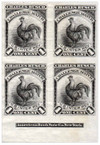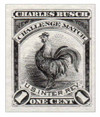
# RO47P3 - 1864 1c Black, Charles Busch, Plate on India Paper
Own Match Tax Revenue Stamp – Missing From Many Collections!
The Tax Act of 1862 provided that companies being taxed under the proprietary schedules could propose stamp designs and submit them to the government and, when approved, pay to have the die made for producing them. In return, the company could advertise on them and buy them at a discount from the general issue stamps. Match stamps are often ornate and beautifully designed, making them fun to collect.
This Match stamp is a proof that was never used, making it easy to see the high level of skill used to produce the design. It was used by Charles Busch and its rooster design has proved popular with collectors. Busch sold matches, fancy goods, and more at No.1 Doyers Street in New York from 1862-1871 before moving to 208 Chatham Street until 1883.
This Match stamp is a striking piece of philatelic history you'll enjoy owning. Get it in your collection today.
Own Match Tax Revenue Stamp – Missing From Many Collections!
The Tax Act of 1862 provided that companies being taxed under the proprietary schedules could propose stamp designs and submit them to the government and, when approved, pay to have the die made for producing them. In return, the company could advertise on them and buy them at a discount from the general issue stamps. Match stamps are often ornate and beautifully designed, making them fun to collect.
This Match stamp is a proof that was never used, making it easy to see the high level of skill used to produce the design. It was used by Charles Busch and its rooster design has proved popular with collectors. Busch sold matches, fancy goods, and more at No.1 Doyers Street in New York from 1862-1871 before moving to 208 Chatham Street until 1883.
This Match stamp is a striking piece of philatelic history you'll enjoy owning. Get it in your collection today.














